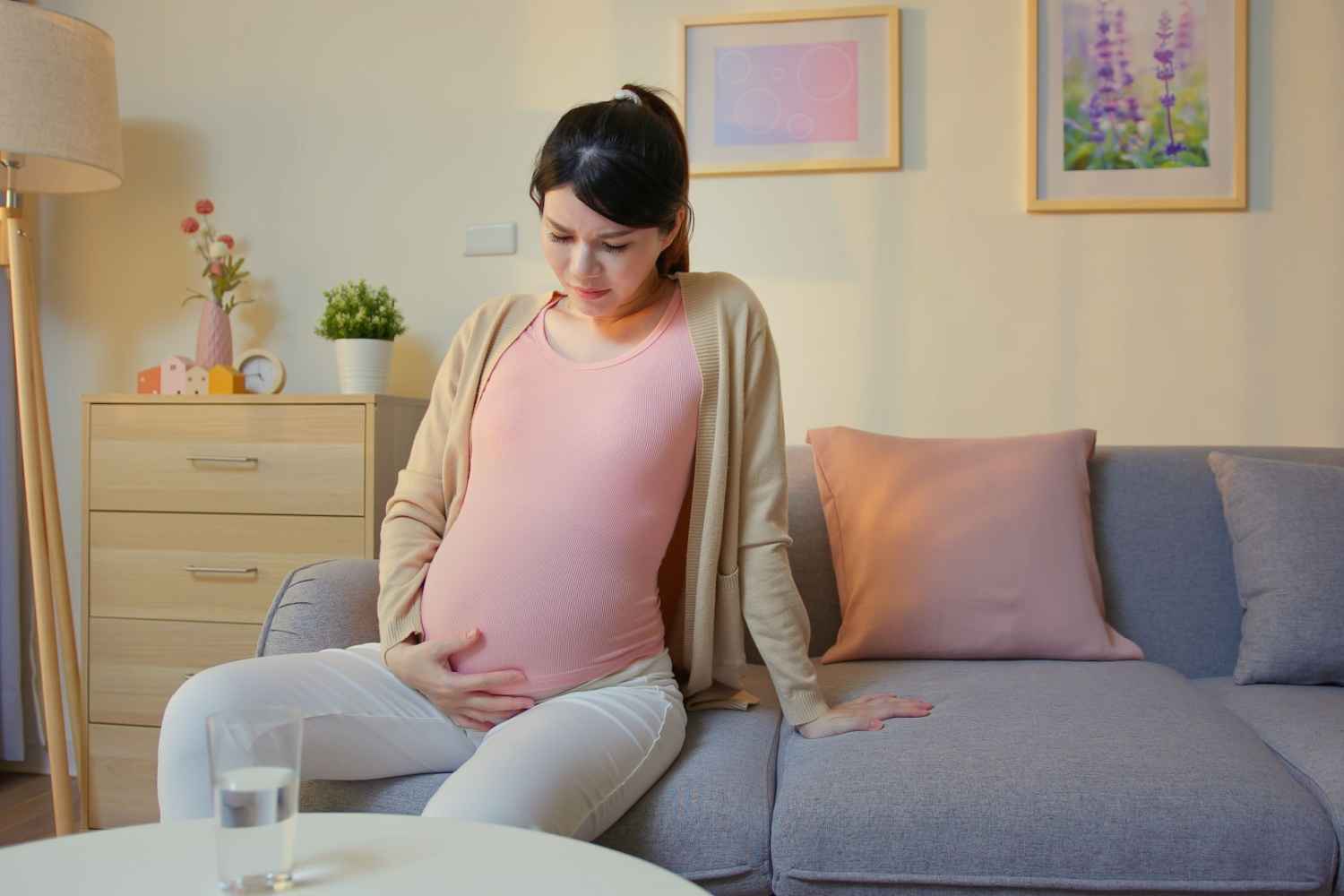
Maintaining good posture during pregnancy is crucial to ensure your overall fitness. When it comes to good posture, it means holding your body in the correct position while sitting, standing, or lying. Knowing some of the best sitting postures during pregnancy can provide support to your body so you can avoid strains and discomfort.
In this article, we’ll walk you through the steps you can take to maintain a good posture during pregnancy. Following the guide below will ensure that you get to learn the right sitting positions that put less or no stress on your back.
In This Article
- What Is Good Posture?
- What Is The Correct Way To Stand And Sit In Pregnancy?
- 7 Sitting Positions To Avoid During Pregnancy
- How To Avoid Lower Back Pain And Pelvic Pain During Pregnancy
- FAQs
What Is Good Posture?
Good posture refers to attaining a position that reduces stress on the body (1). Training your body to achieve a good posture during pregnancy is significant to boost your long-term health. No matter whether you’re sitting, standing, or lying, maintaining a correct posture at every step could be a game-changer. As your baby bump grows, it affects the body mechanics, increasing the risk of injuries. It causes spinal misalignments, which affects the body’s control and coordination.
Acquiring a good posture maintains your musculoskeletal system and improves flexibility and joint mobility. Further, it makes your balance better so that you don’t feel like toppling. Not only that, this can aid with tackling pregnancy symptoms like low back pain, fatigue, strain, etc.
What Is The Correct Way To Stand And Sit In Pregnancy?
Although your body mechanics change during pregnancy, achieving the right posture while moving or sitting can be beneficial. After all, it helps with balance and coordination while minimizing the chances of falling or injuries (2). Here’s the correct way to stand and sit in pregnancy.
For Standing

- Hold your head up straight, keeping the chin in. Avoid tilting your head in any direction (side, back, or front).
- Ensure that your ear lobes line with the middle of your shoulders.
- Keep your shoulders straight so that your chest comes forward.
- Keep your knees straight at some width.
- Stretch your head slightly towards the ceiling.
- Pull your belly in by tightening your abdominal muscles. Do not stress yourself, do as much as you can.
- Avoid moving your pelvis forward and backward. When doing this, keep your buttocks tucked in.
- Disperse your weight equally on both legs while pointing the feet in the same direction.
- Be sure to wear comfortable shoes that maintain the natural arch of your feet. Also, avoid standing in the same position for longer hours. It’s better to change the position from time to time.
- For this, you can place a flat box or stool near your working area and rest your one foot on it. Then, you can switch the position.
For Sitting

- Keep your back straight and your shoulders at the back. Ensure that your buttocks are in touch with the back of the chair.
- It’s better to sit with a back support. You roll up a towel and place it on your lumbar region. This position may help with labor (3). Also, you may look for pregnancy pillows available on the market. However, if you prefer sitting without a pillow, here’s how to sit correctly.
- Sit at the end of the chair in a slouching-like position.
- Draw your body up and shift backward as possible as you can, while maintaining your spine’s natural curve.
- Stay in the position for a few seconds and release it about 10 to 15 degrees (distance from the chair).
- Keep your hips and knees perpendicular (at 90 degrees) so that your legs are at some distance apart. This way, you can disperse your weight evenly on both buttocks. Ensure that you don’t cross your legs while sitting.
Here are some tips to sit correctly during pregnancy.
- Avoid prolonged sitting in one position. It’s good to change the position every 30 minutes.
- It’s better to avoid rolling or pivot chairs for sitting. If you can’t, it’s better to avoid twisting when sitting.
- Move to the front of your chair and stretch your legs a bit before standing.
7 Sitting Positions To Avoid During Pregnancy

Now that you know how to sit correctly, it’s time to know what sitting positions to avoid to ensure maximum comfort. So, here we go.
1. Cross-leg sitting
Sitting while crossing your legs may pressurize blood vessels and muscles. This may cause poor circulation, inflammation, and swollen joints. Further, restricted or poor circulation may raise blood pressure. Plus, it may affect the lumbar spine alignment (4).
2. Sitting in one position
It’s a smart move to switch your sitting positions. Sitting in one position can stress your muscles. You can either switch your position or stand for a while to relax.
3. Dangling leg sitting
Dangling legs while sitting may cause blood circulation issues, low back pain, or leg pain. Hence, you must avoid dangling legs (5). The best to fix this is to adjust the height of your chair so that your feet touch the floor.
How To Avoid Lower Back Pain And Pelvic Pain During Pregnancy

Sitting and standing in the correct posture can reduce the risk of low back pain and pelvic pain. Here are a few things you can keep in mind so that you may avoid these conditions :
1. Avoid Slouching
When we sit at home, we often slouch. During pregnancy, the spinal cord is already strained due to increased weight, slouching makes it worse as it does not keep your back straight. Distribute your body weight on your hips evenly.
2. Avoid Crossing Legs
While sitting do not cross your legs as it decreases blood circulation. Sit in a way that your knees are at level with your hips.
3. Use Backrest
When you are suffering from back pain do not sit on a stool or low back chairs since they do not give your back proper rest. Always use backrests to keep your spinal cord straight during pregnancy. Pregnancy pillows can also be considered.
4. Avoid Hanging Your Legs While Sitting
Pregnant women should not sit with their legs hanging in the air as it causes swelling in the legs. It is due to increased blood flow.
5. Watch Your Weight
Weight gain in pregnancy is good, but it is not wise to be overweight. Try not to be overweight. Have a healthy, nutritionally balanced diet, do some pregnancy exercises, take a swim every now and then, and walk regularly.
6. Watch Your Footwear
If you can avoid high heels it is safe and good for your baby and helps to reduce back pain also. Wear comfortable footwear.
7. Do Not Lift Heavy Weights
This is something about which, generally, all pregnant women are aware.
The key to maintaining correct sitting postures during pregnancy is to balance your spinal and joint alignment. Along with sitting it is required to be careful about your postures while standing, lying down, lying on your side, lying on your back, or during a semi-reclined position. Also, avoid sitting in one position for too long. You may use pillows while lying down to elevate your head or stack them under the knees if required to feel comfortable.
FAQs
1. Does My Sitting Position Affect My Baby?
A wrong sitting position may affect you and your baby. Poor postures in pregnancy can lead to complications such as joint problems, instability, poor blood flow, etc.
2. What Sitting Position To Avoid During Pregnancy?
Sitting positions that involve crossing or dangling legs or prolonged sitting in one position must be avoided. Make sure to sit comfortably while maintaining your posture.
3. Can You Sit Indian Style While Pregnant?
If you’ve been sitting in Indian style throughout your life, there may not be any safety concerns. However, if you have health conditions like joint problems or blood circulation issues, it’s a good idea to avoid sitting in Indian style.
References
- Effect of an exercise program for posture correction on musculoskeletal pain – [https://www.ncbi.nlm.nih.gov/pmc/articles/PMC4499985/]
- The Biomechanics of Pregnancy: A Systematic Review – [https://www.ncbi.nlm.nih.gov/pmc/articles/PMC7739277/]
- Effect of supported sitting position during the second stage of labor on its outcome in primigravidae: A quasi-experimental study – [https://www.ncbi.nlm.nih.gov/pmc/articles/PMC10657044/]
- Cross-legged sitting posture effect on lumbar proprioception in young adults: a cross-sectional study – [https://bfpt.springeropen.com/articles/10.1186/s43161-021-00053-9]
- Effect of positioning on blood pressure measurement in pregnancy – [https://www.sciencedirect.com/science/article/abs/pii/S2210778921005638]

